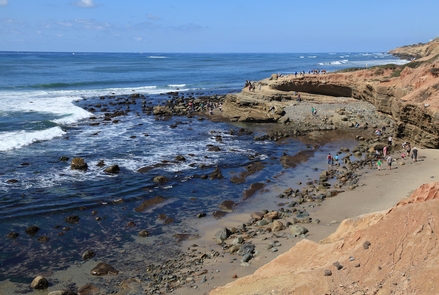Directions
Black Ridge Canyons Wilderness is located approximately 15 miles west of Grand Junction, Colorado. It is bordered by the Colorado National Monument to the east and the Colorado/Utah boundary to the west, with a small portion actually spilling into Utah. The Wilderness is included within the McInnis Canyons National Conservation Area (MCNCA), which was legislatively designated in October of 2000.
Directions
DIRECTIONS TO DEVILS, POLLOCK BENCH, AND FRUITA PALEO AREA: From Grand Junction, take I-70 west to the Fruita exit (#19), turn left and cross back over I-70 and go 1.5 miles to the Kings View Estates subdivision. Turn right, in to the subdivision and stay on the main road. It’s approximately .5 miles to the Devils Canyon trail turnoff, on your left . Approximately 1.5 miles further is Pollock Bench Trailhead.
DIRECTIONS TO KNOWLES AND JONES CANYON TRAILS: From Grand Junction, travel west on Grand Avenue, cross over two bridges, at the next stop light turn left on to Monument Road, turn left at “D” Road. Follow D road until you come to a fork in the road, go left on to Little Park Road. Follow Little Park Road until it meets up with DS Road, take a left on to DS Road to the Glade Park Store. At the Glade Park Store take a right on to 16.5 Road go .5 miles to BS Road, turn left, it’s another 12 miles to the Knowles Canyon trailhead. Continuing on BS Road another 2.5 miles you will come to a locked gate at the end of the public road, this is the trailhead into Jones Canyon.
DIRECTIONS TO RATTLESNAKE ARCHES AND MEE CANYON TRAILS: There are two roads that parallel the southern boundary that are seasonally opened to motorized travel. These roads provide access to Rattlesnake Canyon/Arches and Mee Canyon trailheads. The Upper Road is open from April 15 – August 15, with the Lower Road being open from August 15 – February 15. Both roads are closed to motorized travel from February 15 – April 15. Biking, hiking and horseback are allowed on both access roads throughout the year. CAUTION: A high clearance 4X4 vehicle is required for the last 1.5 miles. Do not drive on either road when wet. From Grand Junction, take I-70 west to the Fruita Exit (#19) turn left at off ramp and cross back over I-70, follow signs to Colorado National Monument (CNM). Enter the CNM. Travel 11 miles from CNM entrance station, turn right at sign for “Glade Park Store”. Travel .2 miles to Black Ridge Access Roads (Upper and Lower). At this point you are adjacent to the Black Ridge Canyons Wilderness. The Rattlesnake Arches trailhead is approximately 13 miles ahead. NOTE: There is no charge for traveling through the Colorado National Monument to access the Black Ridge Canyons Wilderness. Inform the attendant at the entrance gate that your destination is the Black Ridge Canyons Wilderness and you will be permitted to pass through the monument at no cost.
Phone
970-244-3000
Activities
WILDERNESS
Camping Reservations
Reserve your campsite at these camping areas:
Hiking Trails
Looking for nice hiking areas to take a hike? Choose from these scenic hiking trails:
Related Link(s)
More Colorado Recreation Areas
The Black Ridge Canyons Wilderness now contains a total of 75,439 acres and is managed by the Bureau of Land Management. The Wilderness Area consists of 75,439 acres, of which 5,120 are in Utah. Vegetation is relatively sparse with scattered pinyon-juniper woodland. The area’s east-west Black Ridge is dissected by seven red rock canyons varying in length. These canyons feature geological characteristics such as spires, windows, giant alcoves and desert patina. Waterfalls can be found here during spring runoff and after summer thunderstorms. Deer, mountain lion, desert bighorn sheep, as well as golden and bald eagles make the area home. Recreational use of the area focuses upon visiting the canyons in conjunction with calm water float trips through Ruby Canyon and hiking the canyons to view the arches in Rattlesnake and Mee canyons. Visitors can enjoy hiking, horseback riding, hunting, backpacking, and primitive camping, as well as rafting, canoeing and kayaking on the Colorado River. In 2000 the Black Ridge Canyons Wilderness became part of the now over 109 million acre National Wilderness Preservation System. In wilderness, you can enjoy challenging recreational activities and extraordinary opportunities for solitude. In an age of “…increasing population, accompanied by expanding settlement and growing mechanization,…” you play an important role in helping to “…secure for the American people of present and future generations the benefits of an enduring resource of wilderness” as called for by Congress in the Wilderness Act of 1964. Please follow the regulations in place for this area, and use Leave No Trace techniques when visiting to ensure protection of its unique natural and experiential qualities.
How to follow the seven standard Leave No Trace principles differs in different parts of the country (desert vs. Rocky Mountains). Click on any of the principles listed below to learn more about how they apply.
Leave No Trace principles:





